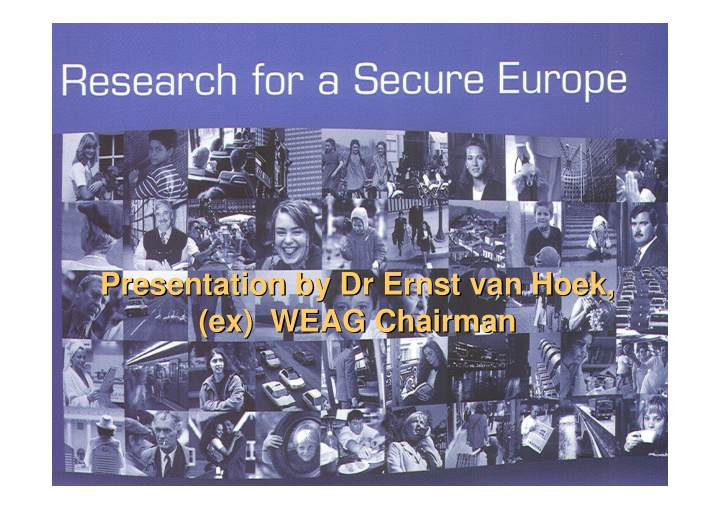



Presentation by Dr Ernst van Hoek, Presentation by Dr Ernst van Hoek, (ex) WEAG ex) WEAG Chairman Chairman (
Lay out • History • What is Security Research? • Relation to Defence Research • How can it work • What it means for Aerospace Research • Conclusions
History • Start in 2003: first exchanges of ideas and setting up of Personalities Group & sherpa’s • Motivation: International Terrorism & Crime biggest concerns of Europeans • So far: EU not involved in Defence or related activities • Personalities Report early 2004 • First projects in 2004
Security Research • Advance capabilities for – information – protection – post disaster management – co-ordinated support • Dealt with at local and regional levels • European wide approach only starting • PASR & ESRP
Security Research (2) • Is not a discipline • Is applied research • Has commonality with Defence Research • Has attracted high interest • Is now politically relevant • This could be a disadvantage as well!
International co-operation • Assumes National activities • Disappearing borders – For citizens – For the economy – For criminals – For terrorists! • Governments slow to adept to it!
Reflection: Defence R&T – International Co-operation • Defence R&T Characteristics: – Cooperation started during Cold War – Applied Research – Outcome protected: limited market mechanisms – Directed by governments – National orientations – Transparency limited – Was important for Allied Success
Security Research & Defence • Defence technology usable • Co-operative tools available • Content: look at inventory of projects (“Assets”) • Can we use them? • We can use at least the ‘Culture’, but probably much more • Role for European Defence Agency – Still to be defined – Will have to be in line with Commission activity
Existing Assets • Tools: – MoU – Contracts / general conditions – Network • Technologies: – Structure - Taxonomy – Multi disciplinary studies – Technical results
Actual application • Radar: – Technologies for new small radars such as FM-CW radar (anti drug use?) – Looking through walls • Materials – Damage tolerance – Self repairing • IT – Internet technologies • Protection: – Flares – Ballistic protection / – Crew safety
Actual application (2) • Modelling and Simulation – Synthetic environment and training – MED-LOG • CB technologies – Detectors – Protection • Space based technologies – High resolution sensors – Low cost ground station (RAPIDS)
Aerospace particular • Vulnerability while flying • Psychological effects highly relevant • Economic impact • Strong high-tech content • Measures should be all inclusive, partial solutions have very limited effect
Aerospace particular (2) • Integrated design for future aircraft • The Human factor will always be the crucial one • Permanent Training & Simulation
Way forward • Seek synergy between projects by defining themes and clusters • Provide link between technologists, industry, policy makers and executive organizations • Think in advance about keeping the advance on lawbreakers / catastrophes
Way forward & Conclusions • As borders lose their meaning, make sure to think in terms of regions / continents in your approach • Only efficient co-operation can make a difference.
Recommend
More recommend